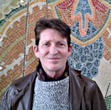Massive Demo In Favour of Unity of Spain in Central Barcelona on Sunday October 8th
There were a few Spanish flags on the street outside the flat on Carrer Mallorca but it wasn’t until I got to the corner of Bruc and Aragó that unionists could be seen in any great numbers. There were busses and Spanish flags everywhere.
Since the early morning there had been Spanish police helicopters flying overhead and I’d seen loads of police vans. Perhaps because of my political position, I felt more tense about this demonstration than I had on the day of the referendum or the general strike.
Another problem was that a lot of busses had brought people in from outside Catalonia. Free trips to Barcelona had been advertised on Twitter and Facebook in order to boost the number of people on the demonstration. It wasn’t mainly Catalans demonstrating and the main language being used was Spanish rather than Catalan.
The atmosphere was more noisy and boisterous than the comparatively sombre Catalan demonstrations. People were singing “Yo soy español, español, español” (I’m Spanish, Spanish, Spanish) and the cars on Carrer Aragó were hooting there horns in support. Spanish rojigualda flags were everywhere some with the crest, others with the Spanish bull on them. There was a group of lads all wearing Spain national team football shirts. I could but feel it was all a little foreign.
I followed the crowds along Aragó to the corner of Roger de Llúria, where everyone turned to go down the hill in the direction of Plaça d’Urquinaona. Because it was Spanish, the atmosphere was quite festive. From the noise from the car and motorbike horns, there was obviously a lot of support for the unionist cause. The crowd was singing “Viva España. Visca Catalunya” (Long live Spain. Long live Catalonia.)
It was worth bearing in mind that this was Sunday 8th October and in four days time, on Thursday 12th, Spain would be celebrating its National Day, which would mean another big demonstration in Barcelona in favour of the unity of Spain and Catalonia. Here it is known as El Dia de la Hispanitat, literally the Day of Spanishness, and in the English-speaking world it’s Columbus Day.
The crowd moved over to the slightly larger Carrer de Pau Claris. In my 30 years in Barcelona, I had never seen so many Spanish flags. I knew it was going to be a big demonstration but I hadn’t expected it to be this big. Once again there were people of all ages representing a broad cross section of Catalan society.
Even accepting that some of them had come from other parts of Spain, I had the sensation that the majority had been born here in Catalonia and had been bussed in from towns and villages outside Barcelona. Outside the city of Barcelona itself, the municipalities that surrounded it of Hospitalet, Sant Adrià, Santa Coloma and Badalona, and the neighbouring counties of El Baix Llobregat and El Vallès were mainly Spanish speaking.
It struck me most strongly that day just how divided Catalan society really was. The only solution was to have a vote on whether to stay in Spain or not. Otherwise the division would remain indefinitely. There definitely was a breach between Catalan speakers, who identify more as being Catalan, and Spanish speakers, who identify more as being Spanish. More chants of “No nos engaña, Cataluña es España” (Don’t try to to trick us, Catalonia is Spain) as we reached the corner of Pau Claris and Gran Via.
One of the reasons why the organisers, Societat Civil Catalana, had chosen to march from Plaça d’Urquinaona down Via Laietana to Estació de França rather than Passeig de Gràcia and Plaça de Catalunya was that these streets were much narrower and gave the sense that there were many more people than there actually were. I don’t think the SCC had expected such a big turnout so by holding it here they were covering their backs and guaranteeing they could get the photo.
“Puigdemont a prisión” and “Cataluña es España” resounded around me. Catalan senyera flags flew alongside Spanish rojigualdas as if to make the point. Other people carried hears with the Catalan, Spanish and European Union flags in them. They definitely didn’t want a border with Spain and it was easy to see why the EU were unwilling to back Catalonia despite the police violence and failure to respect democratic principles. “España unida jamas será vencida!” (Spain united will never be defeated) went the shout from the crowd.
A couple of streets before we got to Plaça d’Urquinaona, it was impossible to move any further because of all the people. There was a sea of Spanish flags before me so I turned into Carrer Casp and started to make my way back up the hill towards home.
This was undoubtedly a massive demonstration but it didn’t compare with the Catalan demonstrations in numbers despite being on a Sunday and busses having been provided to bring people in from other parts of Spain. Having said that most of the people on the march seemed like normal citizens who happened to have another point of view on the political future of Catalonia. They were a little more exuberant than the Catalans but that’s just what the Spanish are like. Also from what I’d seen, it wasn’t fair to call them fascists. They were just just ordinary people.
It seemed to me that the only way to solve this disagreement would be to hold a referendum. As I walked away from the march, the last Spanish flag I saw had “Viva el Rey” (Long live the King) written on it. How could this ever be compatible with most Catalans’ hope of a Republic?
Simon Harris's Blog
- Simon Harris's profile
- 8 followers



